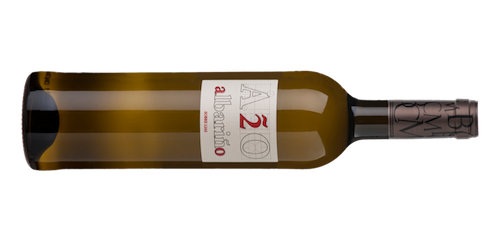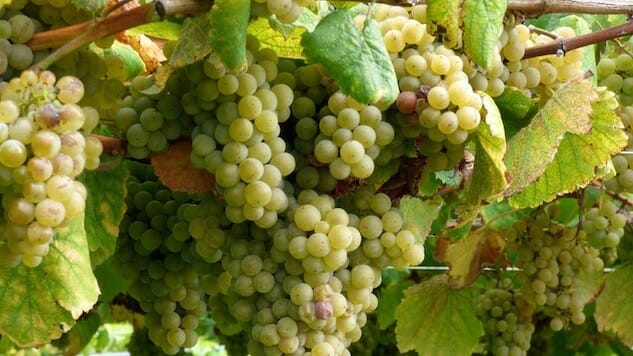Albariño is a pale grape (the name derives from the Latin “albus,” meaning “white”) established in Galicia, Spain, in the Middle Ages. Apparently, there are those who’ve theorized it’s a clone of Riesling (with which it shares some aromatic complexity) and others who believe it might be a clone of Manseng (with which it shares its trademark astringency). We might never know, and luckily, we don’t have to care. What you need to know about Albariño is this: It’s most commonly a Spanish wine, though also popular in Portugal and increasingly toyed with on the west coast. It makes lemony-yellow wines with, usually, a serious lemon-zest kick. It’s light-bodied and acidic and dry and generally has intense aromatics. If you feel like you could love Sauvignon Blanc if it’d just ditch the grass notes, maybe Albariño is the wine you should be playing with (the “green” note you’re somewhat likely to encounter is basil; other than that, expect granite, citrus peel, and peach or nectarine notes). It cuts a hot, humid evening down to size better than just about anything. Do you like shellfish? Then you already have something in common with this coast-loving wine.
Albariño is not a la-de-da varietal, so if zippy, acid-forward, bracing type white wines are your thing this is one where the quality to price point ratio is generally excellent. While it often has a very complex bouquet it’s not a demanding wine at all, and is easy to pair and very easy to drink. In fact, it’s easy to drink quite a large amount of it, so for those of you who care about your waistline and/or your drivers’ license, please bear in mind that this stuff only seems like extra good flavored water.
Albariño can be aged some (5 years or so) but most people don’t do it. I’m going to say don’t bother if it has a screw cap and don’t bother if you’d be unpleasantly surprised by the bold fruitiness taking a hit because it well could (some oeno-geeks will certainly disagree and that’s OK). Albariño can safely be considered a “drink it right now” wine. No one will judge you here.
Seven Bottles to Try

Bodegas Castro Martin A2O Albariño (Rias Biaxas, Spain, $12)
A-to-the-O, not A-twenty. Intense aromatics and feisty acidity. This one’s on the ripe side, exhibiting notes of melon and peach, with a little lemon and a clean and slightly honeyed finish. Serve it well-chilled. It’s a coast-loving grape and goes perfectly with simply prepared seafood. It can also be a friend to potato salad, spring rolls, or burrata.
Burgans Albariño (Rias Baixas, Spain, $14)
If “stony” is your thing you might be on the lookout for this character. But it’s also relatively rich. Pale greenish-gold with an apricot and lemon nose, a long wet-rock finish and a lot of peach, apple, lemon and grapefruit in between. It has a certain stateliness but it isn’t stuffy.
Laxas Albariño (Rias Baixas, Spain, $22)
A pale beauty with more of an emphasis on stone fruit than lemons and grapefruit, this easygoing wine still has a kind of acidity that could justifiably be called “vivacious” or “perky.” It’s layered and generous, with apricot and nectarine notes dominating, and a little bit of green apple. There’s a touch of honeydew melon on the finish.
Marques de Vizhoja Señor de Folla Verde (Rias Baixas, Spain, $13)
OK: This stuff is just so good. Albariño, blended with local natives Loureira and Treixadoura. Golden tint, quite sweet on the nose, very substantial on the palate with a mix of floral, fruity and savory notes. Apple, fennel and pear stand out. Long, long finish. Full-bodied but very lively, this wine will pair well with pork or rich seafood dishes. Also, probably tons of other stuff.
Maryhill Proprietor’s Reserve Albarino (Columbia Valley, WA, $20)
Tourist note: The Columbia Valley is a vast AVA that crosses a state line and runs the gamut from high desert to windy river gorge, and there are an amazing array of teensy little places you might not find unless you know you are looking for them. One of the easier wines to find in your local market and also one with a superb tasting spot overlooking the Columbia River and Mount Hood, Maryhill produces way more varietal wines than any one winemaker should be able to do well, but Richard Batchelor does. Their Albariño is fruity, light on its feet, and has a lush nose (apples and pears dominating with a bit of a spring blossom and honeysuckle trace. On the palate it’s a citrus-fest with a hint of pineapple. Summery and sociable.
Pazo de Lusco Albariño 2016 ($24.99)
OK: this one might be worth aging to see what happens. I mean, if you can. Probably the most serious wine on the list, this stuff has structure for days and a sort of piercing quality. It’s stately. It’s stony. It’s dense and robust, with orange and lemon zest aromatics and strong granite minerality. It has a long finish and a very luscious texture. Out of everything mentioned here this is the one I’d try (try) to save for a special occasion. Do it a favor and let it hang out with its longtime best friend, shellfish.
Tangent Albariño (Paso Robles CA $17)
Tangent was one of the first California wineries to make Albariño a significant part of its portfolio, and they make two great ones (the smaller-batch concrete egg-aged version is a little more expensive but worth seeking out if you can; we’ll focus on the more accessible one). In the “liquid sunshine” category, this wine has a sensuous quality and a heady nose of apricot jam, pears and peaches, along with the citrus notes without which it pretty much wouldn’t be Albariño. Long finish with earthy and stony traces. Aromatically wonderful and ready to go wherever you’re going.

